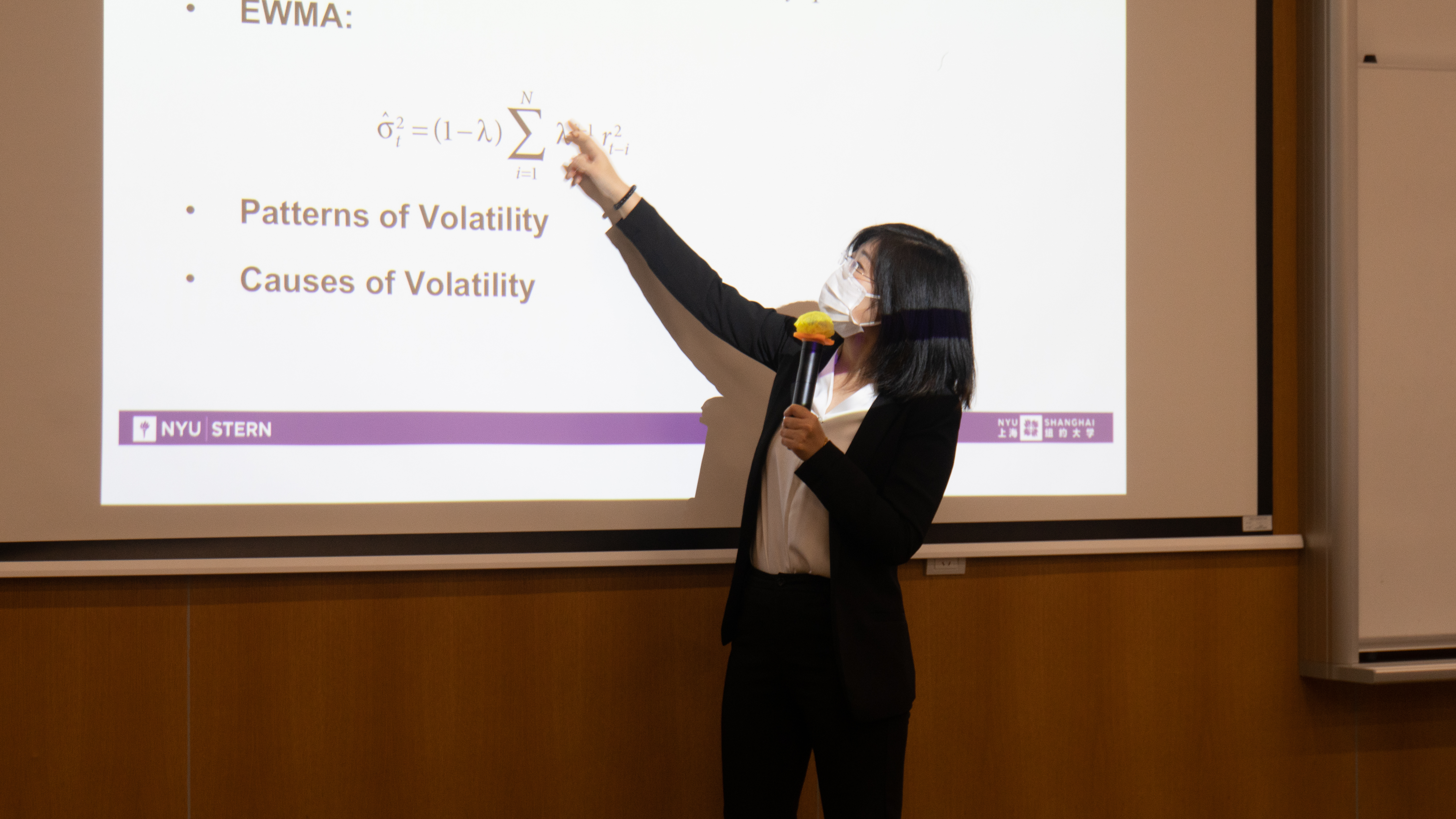In the lead-up to the 2020 United States presidential election, most onlookers bided their time debating the merits of two diametrically opposed candidates. In the world of finance, however, at firms large and small from Shanghai to New York to London, most were focused on a different exercise - attempting to predict how the outcome of the election would impact global trading and commodities markets. Known as volatility modeling, this field of practice focuses on using sophisticated approaches to measure risk in financial assets and anticipate how events in an inherently unpredictable world can impact business.
In NYU Shanghai and NYU Stern’s joint Master of Science program in Quantitative Finance, Professor Christina Wang’s course on volatility modeling equips students with the tools needed to one day join the ranks of those leading firms specializing in this area. Wang states, “The world in 2020 is a rapidly changing one. An event like the global pandemic accelerates volatility in markets. Students have to understand this concept now, not next year.”

Heavily oriented around quantitative tools and applied statistics, students in Wang’s course learn the seminal volatility theories, analyze case studies, apply ARCH and GARCH models to real data, and work on R-based projects to better calculate VaR (value at risk).
“The skill of measuring risk is fundamental to volatility modeling and required to succeed in the financial profession today. My hope is that after taking the course, students will have a competitive edge when they explore their career options,” Wang says. “Students can also really start to comprehend wealth management and how to realize big gains in the market.”
Wang shows how volatility materializes in global and Chinese markets, and how models can be constructed to decode it. By then building those models and implementing them toward actual financial fact patterns, students gain real-world experience in the science of this demanding discipline. Yan Kelin, MSQF ‘21, recalls how early in the course he and his classmates were tasked with using quantitative data sets to forecast various portfolio performances. “For one assignment, I used the VaR model to manage an options portfolio and control the risks just like a real financial professional,” relates Yan.
While Yan had majored in finance and economics as an undergraduate, he remembers his studies then being more rooted in a qualitative perspective and appreciates how Wang’s approach, more applied and more quantitatively based, has given him a new lens through which to understand finance.

Wang provides her students with an intensive and rigorous grounding that surveys a range of topics, from correlation formulas to option implied volatility to high-frequency trading (HFT). Chi Ruixin, MSQF ’21, joined the MSQF program following four years of undergraduate study at Australia National University. To Chi, a subject like HFT had always been a complex concept. However, after applying volatility models learned in Wang’s course, Chi is now better able to untangle the massive equations that underpin HFT and understand their financial implications.
“Professor Wang’s course has been the most technical out of all the courses taken in our graduate program so far. It has been a great opportunity to build our quantitative skills,” Chi explains.
To supplement lectures and provide additional expert insights from academia and industry, Wang also invites guest speakers to present in class. During one session, Xin Zhou, Executive Director of NYU Shanghai’s Volatility Institute (VINS), explains the anatomy of volatility in China and how VINS’ computer models, such as VINSIGHT, in collaboration with NYU Stern’s V-LAB, produce over 63,000 financial data sets a day.
In another session, Qi Wang, Director at the China Financial Futures Exchange (CFFEX), comes to present about options trading. Before concluding his guest appearance in class, Wang fields a question from a student and then shifts his talk to the subject of how the CFFEX conducts variance swaps. The moment not only typifies the frequent kind of stimulating student-professor exchange that occurs in Wang’s course, but also how often Wang’s lessons intersect with real-world practical applications.
For their final projects, students present their own volatility modeling applications, analyzing the impact of COVID-19 on financial trends across various industries. While some train their microscope upon technology and video content streaming services such as Netflix, others examine the electric vehicle industry and its bellwether, Tesla. Using GARCH predictions, students determine which sectors or companies might be susceptible to higher volatility ratings and propose optimal investment strategies learned in class such as the Butterfly Spread or Straddle.
For example, Han Yujian, Wang Ran, and Li Xinyu, all MSQF ‘21, investigate the volatility of state-owned Chinese enterprises compared to non-SOEs by using both a regression analysis and the GARCH model. With 95 percent regression significance and a GARCH model that confirms their findings, the trio conclude that SOEs have a lower volatility rate and are attractive for investors. Han also asserts that volatility among SOEs is a product of two factors: government policy and investor perceptions of that policy. In other words, Han states, “finance is a quantitative subject, but changes through human intervention.”
Throughout her academic career, Professor Wang’s studies have inspired her teaching. Now, it is her teaching that inspires her students, imparting knowledge on the unique branch of finance that is known as volatility modeling and the skills they will need to both understand current trends and be prepared for future success.


